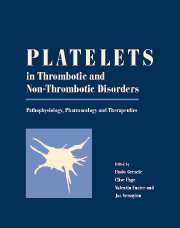Book contents
- Frontmatter
- Contents
- List of contributors
- Editors' preface
- PART I PHYSIOLOGY
- 1 History of platelets
- 2 Production of platelets
- 3 Morphology and ultrastructure of platelets
- 4 Platelet heterogeneity: physiology and pathological consequences
- 5 Platelet membrane proteins as adhesion receptors
- 6 Dynamics of the platelet cytoskeleton
- 7 Platelet organelles
- 8 Platelet receptors for thrombin
- 9 Platelet receptors: ADP
- 10 Platelet receptors: prostanoids
- 11 Platelet receptors: collagen
- 12 Platelet receptors: von Willebrand factor
- 13 Platelet receptors: fibrinogen
- 14 Platelet signalling: GTP-binding proteins
- 15 Platelet phospholipases A2
- 16 Roles of phospholipase C and phospholipase D in receptor-mediated platelet activation
- 17 Platelet signalling: calcium
- 18 Platelet signalling: protein kinase C
- 19 Platelet signalling: tyrosine kinases
- 20 Platelet signalling: cAMP and cGMP
- 21 Platelet adhesion
- 22 The platelet shape change
- 23 Aggregation
- 24 Amplification loops: release reaction
- 25 Amplification loops: thromboxane generation
- 26 Platelet procoagulant activities: the amplification loops between platelets and the plasmatic clotting system
- 27 Platelets and chemotaxis
- 28 Platelet–leukocyte interactions relevant to vascular damage and thrombosis
- 29 Vascular control of platelet function
- PART II METHODOLOGY
- PART III PATHOLOGY
- PART IV PHARMOLOGY
- PART V THERAPY
- Afterword: Platelets: a personal story
- Index
- Plate section
17 - Platelet signalling: calcium
from PART I - PHYSIOLOGY
Published online by Cambridge University Press: 10 May 2010
- Frontmatter
- Contents
- List of contributors
- Editors' preface
- PART I PHYSIOLOGY
- 1 History of platelets
- 2 Production of platelets
- 3 Morphology and ultrastructure of platelets
- 4 Platelet heterogeneity: physiology and pathological consequences
- 5 Platelet membrane proteins as adhesion receptors
- 6 Dynamics of the platelet cytoskeleton
- 7 Platelet organelles
- 8 Platelet receptors for thrombin
- 9 Platelet receptors: ADP
- 10 Platelet receptors: prostanoids
- 11 Platelet receptors: collagen
- 12 Platelet receptors: von Willebrand factor
- 13 Platelet receptors: fibrinogen
- 14 Platelet signalling: GTP-binding proteins
- 15 Platelet phospholipases A2
- 16 Roles of phospholipase C and phospholipase D in receptor-mediated platelet activation
- 17 Platelet signalling: calcium
- 18 Platelet signalling: protein kinase C
- 19 Platelet signalling: tyrosine kinases
- 20 Platelet signalling: cAMP and cGMP
- 21 Platelet adhesion
- 22 The platelet shape change
- 23 Aggregation
- 24 Amplification loops: release reaction
- 25 Amplification loops: thromboxane generation
- 26 Platelet procoagulant activities: the amplification loops between platelets and the plasmatic clotting system
- 27 Platelets and chemotaxis
- 28 Platelet–leukocyte interactions relevant to vascular damage and thrombosis
- 29 Vascular control of platelet function
- PART II METHODOLOGY
- PART III PATHOLOGY
- PART IV PHARMOLOGY
- PART V THERAPY
- Afterword: Platelets: a personal story
- Index
- Plate section
Summary
Introduction
An increase in the cytosolic calcium concentration [Ca2+]i is a major signal underlying platelet activation. Physiological agonists increase the [Ca2+]i by stimulating both the release of Ca2+ from intracellular stores in the endoplasmic reticulum (ER) and the entry of Ca2+ across the plasma membrane (PM). After stimulation, the [Ca2+]i can be reduced by sequestration of Ca2+ into the ER and extrusion across the PM. The Ca2+ -ATPases responsible also maintain the [Ca2+]i around 30–50 nM in resting platelets by working against the leakage of Ca2+ into the cytosol from the ER and across the PM.
The release of stored Ca2+
Most platelet agonists are able to release stored Ca2+ from the ER (the dense tubular system of platelets). The occupation of surface receptors results in the activation of phospholipase C (PLC) and so the formation of the Ca2+ releasing messenger, inositol 1, 4, 5-trisphosphate (IP3), which acts on receptors on the ER. Many platelet agonists, including ADP, platelet activating factor (PAF), thrombin and thromboxane A2, have been shown to activate PLC-β1 via a heterotrimeric GTP-binding protein3. PAF and thrombin also appear to activate PLC-γ1, and thrombin and collagen activate PLC-γ2.
Platelets are reported to express three isoforms of the IP3 receptor (IP3R): IP3R types I, II and III. IP3RI has been located in the intracellular membranes, in contrast to IP3RIII which has been found exclusively at the PM. The IP3RII has been found associated with both internal membranes and the PM.
- Type
- Chapter
- Information
- Platelets in Thrombotic and Non-Thrombotic DisordersPathophysiology, Pharmacology and Therapeutics, pp. 260 - 271Publisher: Cambridge University PressPrint publication year: 2002
- 11
- Cited by

